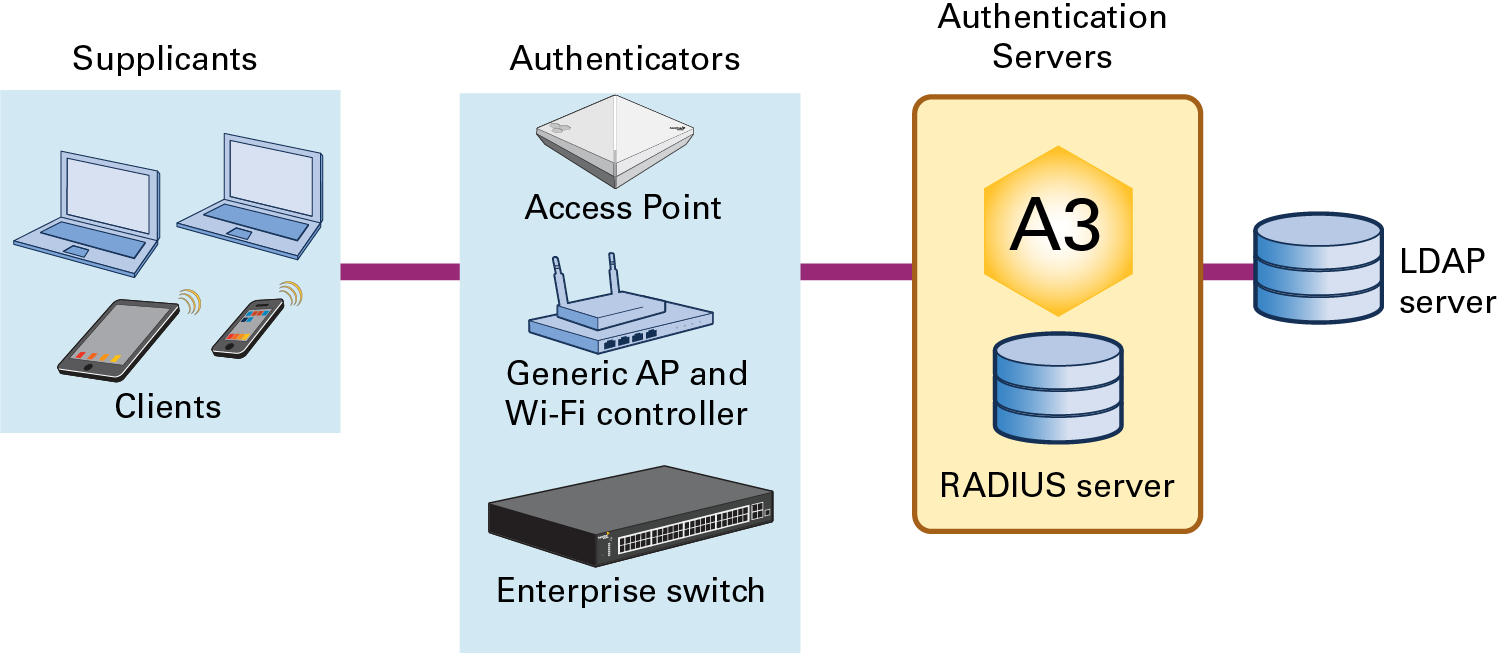Home > Theory of Operation > Authentication Methods

 |
External authentication sources utilize identity information obtained either directly or indirectly from the client. An identity confirmation is used in all cases except for the null authentication source. All external authentication sources work in conjunction with the CWP (captive web portal), customization of which is discussed in Portal Modules. The CWP can required the client to agree to a Terms of Service/Acceptable Use Policy agreement before being allowed access.
A wide range of social media authentication mechanisms are used.
The external authentication sources are:
The A3 administrator must pre-configure access on the social media site to obtain several security parameters. These parameters are entered into A3 as part of the definition of a social media authentication source.
The registration for social media authentication methods supported by A3 are:
Note that the registration process for each of the sites is maintained by the social media vendor and can change without notice. The registration procedure for each of the social login sites is covered in one of the A3 Installation and Usage Guides (Installation and Usage Guide - Registration VLAN or Installation and Usage Guide - No Registration VLAN).
Internal authentication sources are methods for which the organization deploying A3 has control. Only internal authentication sources can be used for 802.1x/EAP authentication. The sources that are available are:
When used, exclusive authentication sources must be the only authentication source used in a connection profile. Several authentication sources are included in the exclusive category:
Billing authentication sources provide authentication following successful payment. The A3 administrator must pre-configure access on the billing site to obtain several security parameters. These parameters are entered into A3 as part of the definition of a billing authentication source.
Billing tiers are defined in Configuration > Advanced Configuration > Billing Tiers. The means by which each is pre-configured is described below. Note that the registration process for each of the sites is maintained by the vendor and can change without notice.
The sources that are available are described in:
Registration for each of the billing sources is covered in one of the Installation and Usage Guides.
RBAC (Role-based Access Control) authenticates users and their devices with information provided by device-resident supplicant software. This information is matched against internal databases such as AD. 802.1X protocols define the way in which the components talk to each other. A variety of encryption techniques are used to ensure the security of 802.1X protocol messages, including the EAP (Extensible Access Protocol). EAP variants are covered inExtended Authentication Protocol (EAP) and X.509 Certificates. EAP requires X.509 digital certificates, which are covered in PKI Providers.
The figure below illustrates the components involved in RBAC.

Supplicants
Supplicants are client devices that seek access to the network. They run device-resident supplicant software that supplies credential information to the authentication server.
Some common credentials include:
One or more credentials can be required by the authenticator. Supplicants can be integrated with the client OS, or supplied by third parties. Installing and configuring supplicants can be a time-consuming and complex task. You can automate this and other configuration tasks using automation and MDM (mobile device managers), which are described in Provisioners.
Authenticator
An authenticator is a device that blocks or allows traffic to pass through its ports. Many types of devices can serve as authenticators:
Authentication Servers
Depending on the type of authentication you use, a number of servers can be involved. At a minimum they include:
EAP is an authentication framework that facilitates secure communications between clients and authentication servers. The figure below is a simplified network diagram featuring Extreme Networks components.

An AP serves as the Authenticator. Messages from clients to the AP are sent using the EAPoL (EAP over LAN) protocol. They are then encapsulated in RADIUS messages and sent to A3.
Most EAP methods use X.509 digital certificates to ensure identity and to set up encryption. Three possible certificates are required:
X.509 certificates are generated and maintained as part of a Public Key Infrastructure (PKI), which is covered in PKI Providers.
EAP Methods
The EAP framework makes possible a number of methods for the secure exchange of identity. The client dictates which EAP methods are acceptable. The client and server negotiate which of the acceptable methods they have in common will be used. The EAP methods that are available in A3 are shown below. You can select more supported methods using the administrative interface.
A3 works with a number of social media web sites using the OAuth2 protocol defined in RFP 6749 - The Oauth 2.0 Authorization Framework.
These social media sites include Facebook, Github, Google, Instagram, Kickbox, Linkedin, OpenID, Pinterest, Twilio, Twitter, and WindowsLive. To use any of these sites in a web-based authentication, the A3 administrator must register with the OAuth provider to obtain two pieces of information: an API ID that identifies the A3 site or sites, and an API Secret that authenticates the site or sites. During the registration process the administrator provides identification information and a callback URL, which is used at run-time.
Social login technology is discussed in one of the Installation and Usage guides.
Copyright © 2021 Extreme Networks. All rights reserved. Published April 2021.